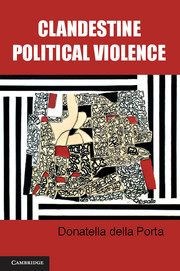Book contents
- Frontmatter
- Contents
- Acknowledgments
- Acronyms
- 1 Political Violence and Social Movements
- 2 Escalating Policing
- 3 Competitive Escalation
- 4 The Activation of Militant Networks
- 5 Organizational Compartmentalization
- 6 Action Militarization
- 7 Ideological Encapsulation
- 8 Militant Enclosure
- 9 Leaving Clandestinity?
- 10 Clandestine Political Violence
- Primary Sources
- Bibliographical References
- Index
5 - Organizational Compartmentalization
Published online by Cambridge University Press: 05 April 2013
- Frontmatter
- Contents
- Acknowledgments
- Acronyms
- 1 Political Violence and Social Movements
- 2 Escalating Policing
- 3 Competitive Escalation
- 4 The Activation of Militant Networks
- 5 Organizational Compartmentalization
- 6 Action Militarization
- 7 Ideological Encapsulation
- 8 Militant Enclosure
- 9 Leaving Clandestinity?
- 10 Clandestine Political Violence
- Primary Sources
- Bibliographical References
- Index
Summary
ORGANIZATIONAL COMPARTMENTALIZATION: AN INTRODUCTION
Parallel to, and partially overlapping with, the organization of Ordine Nuovo were the Nuclei Territoriali di Difesa dello Stato or NDS, which operated under the direction of the army, and had as one of their goals the implementation of a so-called Piano di Sopravvivenza, consisting ostensibly of resistance or guerrilla action in the event of a Soviet invasion. . .. The Nuclei were divided into Legions (up to thirty-six in all) and each Legion consisted of civilian and ex-military personnel who could be relied upon as staunch anti-communists and be trained and eventually utilised by the army. The fifth Legion, active in Verona, was led by Major (later Colonel and then General) Amos Spiazzi, who, by his own admission, started to recruit neo-fascist and neo Nazi elements, so much so that he practically incorporated the Verona group of Ordine Nuovo into the Nuclei.
(Minna 1984: 35–6)There are the conditions for a spontaneous struggle, SPONTANEISM! Be then the slogan that the vanguard sends to comrades. To make a Cuib, three or four comrades are sufficient.
(Quex, no. 2, 1979: 8, cited in Ferraresi 1995: 282)Although the organizational characteristics of groups in clandestinity have been considered as relevant in understanding their choices, as these two quotes, which refer to Italian radical Right clandestine groups, show, they do indeed vary. In particular, they indicate that the organizational structure in the Italian radical Right changed dramatically in the course of a decade, moving from a hierarchical to a horizontal structure.
In the evolution of social movements in all of the types of clandestine violence examined in this text, we have witnessed both the radicalization of some social movement organizations (SMOs) and the moderation of others. As mentioned (see Chapter 3), we therefore have to look for specific explanations for both contrasting paths by considering the effect of the protest cycle on different SMOs and trying to explain their institutionalization, disappearance, or radicalization.
- Type
- Chapter
- Information
- Clandestine Political Violence , pp. 146 - 173Publisher: Cambridge University PressPrint publication year: 2013



